#core contemporary
Explore tagged Tumblr posts
Text
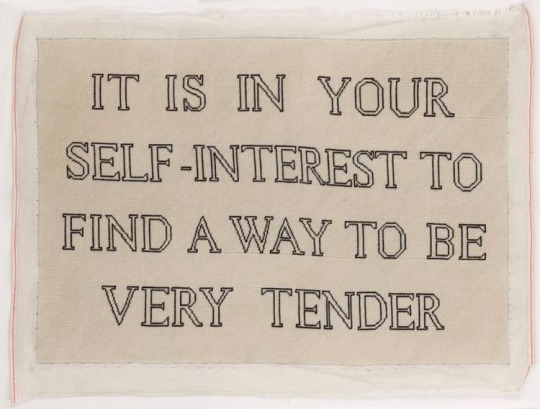
jenny holzer
#love core#girl core#lovecore#girlcore#contemporary art#contemporary#contemporarypoetry#poetry#abstract art#artwork#abstract#nature poetry#jenny holzer#weird core#ocean core#corecore#boy core#nature core#textile art#textiles#graphic design#text post#text art
59K notes
·
View notes
Text

what more can I give you
#art#figure#photography#gothic#goth#ghost#shapes#dark#dark aesthetic#eerie#eerie aesthetic#dark figures#dark art#darkness#eeriecore#sacrifice#gothcore#dark core gothique#gothic aesthetic#goth aesthetic#macabre#surreal#surrender#surreal art#contemporary art#dancer#draping
276 notes
·
View notes
Text

A witch of the Naig-Troibadnnas (Yellowtail river valley) people, resting and enjoying a smoke of the mild stimulant brolge leaf on a hot summer day.
Witches are a small part of the everyday cultural framework among the Hill Tribes. They are individuals considered born possessed by a virgranul, a type of disembodied wild spirit that seeks to inhabit human flesh, either entering the body at the moment of conception, or entering the body at the moment of death. The latter is a dire circumstance that requires significant intercession to fix (the dead body may wander off without rites, leaving the person's soul trapped and liable to warp into the dangerous fuldaigh spirit), while the former circumstance is what causes a person to be born a witch.
In the case of those afflicted in the womb, possession by virgranul is lifelong, and is both a curse and blessing- it divides and isolates them from the human world and causes other wild spirits (both benevolent and malicious) to be perpetually drawn to them, but also allows for them to be attuned to the subtleties of spirits, and able to work magic and divination that the everyday person is incapable of.
Witches are usually recognized from a young age due to marked behavioral differences or atypical development, though are sometimes simply identified as such without obvious behavioral indications, by other witches having read signs of their coming. Their occurrence is not frequent, usually once in a generation for any given tribe. An identified witch child will be taken from their family (the timing varies by tradition, though is usually upon puberty) and into mentorship by an established witch, who will impart their accumulated knowledge and skill and teach the child how to best harness their condition.
One can be a witch regardless of their gender, with the only commonality being that they must remain unmarried, and are expected to never have children (deemed too dangerous, unavoidably placing a child in the path of potentially harmful wild spirits). With no spouses or children to support them in holding a household and herds, witches are instead supported by their communities as means of payment for their services. They typically live in semi-isolation in the boundaries between the village and wilderness (a reflection of their own division between the world of people and of wild spirits, and a protective measure for their communities), and will periodically be brought needed supplies. They do not commonly enter villages unless summoned, or for the sake of certain holidays and festivals, and live most of their lives in seclusion aside from any given mentee (who will in turn care for their mentor in old age).
The societal function of witches is as intermediaries between people and their ancestors, people and wild spirits, and as especially skilled performers of practical magic (most commonly weaving protective spells into worn items, such as clothing or the nose rings of cattle). Forms of practical magic and intercession with ancestors and spirits are performed by all members of society, but a witch has intimate, detailed knowledge of such things and tremendous natural skill that makes them an invaluable asset.
Witches personally discern the identities of the spirits living in any given area and will attempt to familiarize themselves with them, learning in depth about their ways, giving warnings of where the particularly dangerous (or mischievous) ones are, and giving recommendations on which will be receptive to offerings in return for boons. When a village needs to commune with a particularly powerful or dangerous spirit (such as a wildfolk witch), they will commonly send their own witch as an intermediary.
They are ascribed have the ability to directly summon ancestors (who otherwise come and go of their own volition, and rarely ever deign to come at the call of one who is not their descendant). This is of great use when a person finds themselves punished by their ancestors with no certainty as to why, or cases where an orphaned child's ancestry must be identified to gain them proper spiritual support.
They are also regarded as having innate qualities of divination, particularly in reading birdsign (itself generally acknowledged as communication from ancestors, and occasionally gods). The average person has basic knowledge in reading omens of birds and a learned repertoire of key signs, but a witch can divine the messages of birdsign in immense and specific detail, through a vast knowledge system of the meanings of the species, sex, flight direction, gaze, prey, number, and songs of birds. It is common for people to approach a witch for a reading of the skies before undertaking a significant venture or life change, in order to receive detailed and specific advice.
Witches are always literate (and will be taught to read and write by their mentor if they cannot already) and will record their repositories of knowledge in tomes. These are items of absolute secrecy and taboo for a non-witch to touch (the consequences can be severe, you really don't want a witch ancestor-spirit upset with you). Witches can often become competitive about the knowledge stored in these tomes and are known to organize heists amongst themselves in order to gain access to each other's secrets. Most people avoid getting themselves entangled into the complicated rivalries of witches, as these competitions can get ugly and result in many a petty curse if one gains a witch's ire.
---
The only visual cue distinguishing this man as a witch is the tattoos on his forearms, otherwise usually regarded as inappropriate to mark in the contemporary Hill Tribes cultural sphere (the face, upper arms, and sternum is reserved for important clan/tribe/ancestry identification, hands and forearms are reserved for witches, and the rest of the body is appropriate for decoration). These unique forearm tattoos indicate his ancestral connection with a lineage of witches, not blood ancestry but rather the generations of mentors that have produced him. The lines extending down to his fingers are the newest, indicating that he has fully mentored another witch and gained a place in this ancestral line.
The rest of the tattoos here are tribe and blood ancestry identifiers (on the face and upper arms respectively, worn by all members of society), and purely decorative imagery (visible here is a deer, horse, eagle, and a dragon). He also has a snake on his forearm, applied decades ago in an act of youthful rebellion, which has since gotten in the way of critical open skin space.
His clothing is otherwise typical wear for warm seasonal conditions- a man's wool shawl and woven belt, short trousers, decorative deer hide (distinct to the Naig-Troibadnnas), and sandals (these are imported Wardi style sandals, which have been modified with preferred elevated heels). The horn shaped torc on his forearm identifies him as an esteemed elder.
#I think I mentioned the witch tradition by implication in a couple posts but it hasn't come up directly#Witches here are very frequently going to be autistic or having other developmental disorders- with non neurotypical development#and behavior (though without marked intellectual disability) being seen as the impact of possession by virganul.#There's a parallel tradition of witches among the contemporary Finns (distant sibling cultural group to the Hill Tribes) but of MUCH#more core societal significance in which witch-kings are the central figures of power.#Both developed out of common ancestral traditions which diminished in centrality in the Highlands (witches going from clan#leaders to 'guy living on the outskirts of your village who you go to for magical assistance') and increased in centrality in Finns#(witches going from clan leaders to kings with magical powers granted by the gods)#You see a version of the historical predecessor for witches in the drawing of Kulyos and Bernike wrt his forearm tattoos#The proto-Hill Tribes would have regarded their chieftains as a type of witch and the tradition of marking the forearms would#have originally been exclusive to said chieftains. The societal centrality of witches has been lost but they retain traditions of#markings that would have originally identified them as leaders.#(That drawing is also a imaginative though and not just for the bird woman. He's wearing contemporary dress.)#hill tribes#\
228 notes
·
View notes
Text
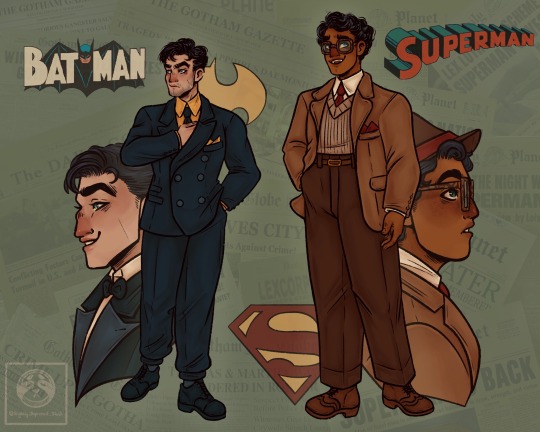
Experimenting with how I wanna draw Clark and Bruce, decided it would be best to draw them side by side to make sure they don’t look too similar *cough cough* Dc *cough*, also been wanting to draw them in 1940’s suits so combined them into one.
As always click for better quality
COMMISSIONS OPEN
+ Underwear version so that I could actually see their body types for reference later
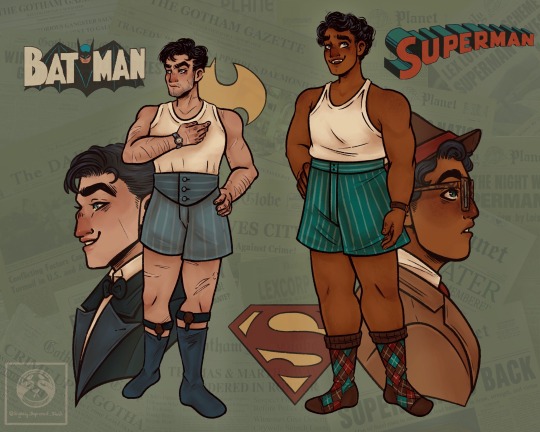
Bonus; Clean profiles!
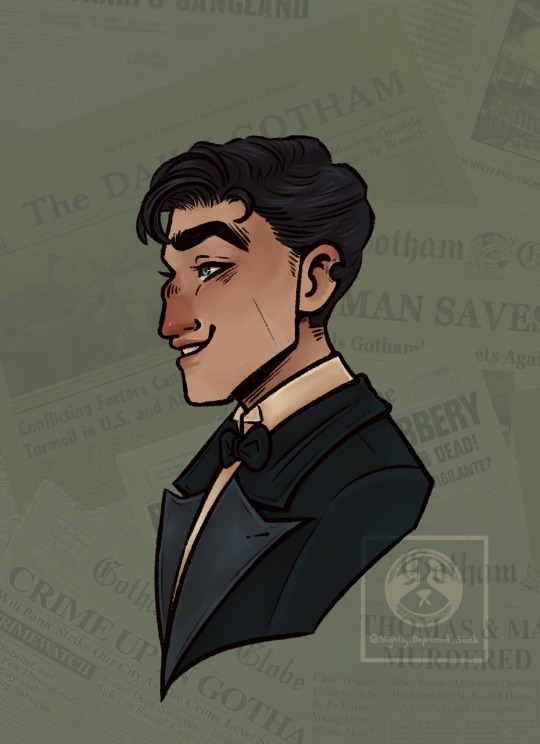
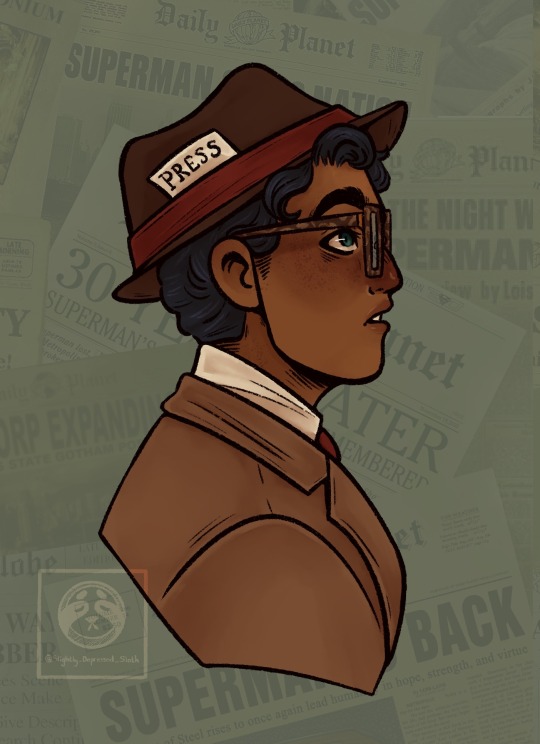
ID + refs under cut;
[ID; Digital drawing of Bruce Wayne and Clark Kent standing, both are dressed in 1940’s clothes. Bruce is on the left in a dark navy double breasted suit, with a black tie and yellow shirt, he has a five o’clock shadow and a scar on his cheek and ear. Clark is dressed in a brown suit, with a mismatched jacket and trousers, his trousers are darker and high waisted with a thin belt, his jacket is open and underneath he’s wearing a beige knitted sweater vest with a red tie and white shirt. Clark’s glasses are thick and tortoise shell in pattern. There’s a second drawing, which is in the same poses as the first but both men are in boxers and vests of the period. Behind each of them is a drawing of their face at profile view, Bruce is in full Bruce Wayne persona in his, clean shaven, properly washed for once and with makeup to cover his eye bags, he’s in a black tuxedo and smiling. Clark in his profile is in his above suit plus a fedora with a red band holding a press pass in his hat, he’s looking up in interest. The background to both is faded newspaper clipping of the Gotham gazette and the daily planet along with the superman and Batman symbol. End ID]
Here’s the references I based their clothes on btw, in case you’re interested!

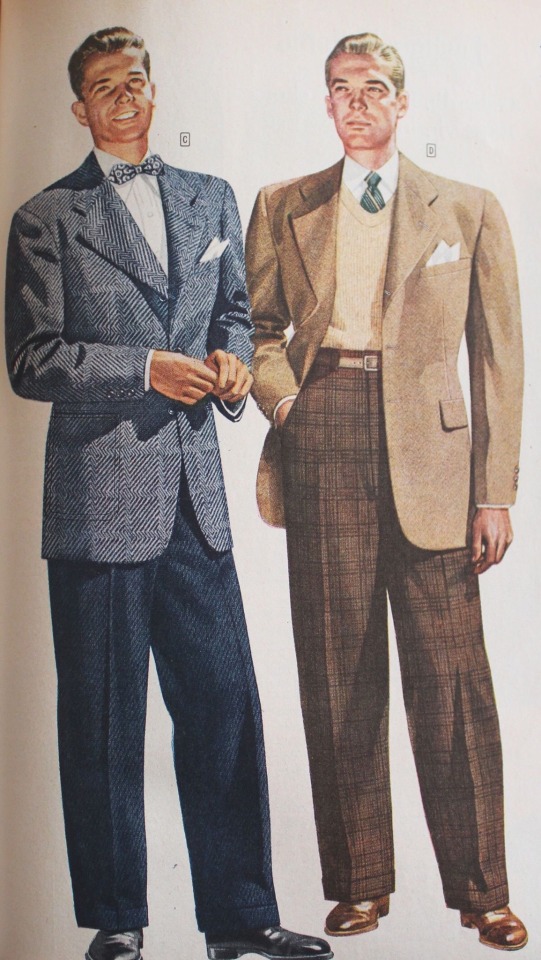
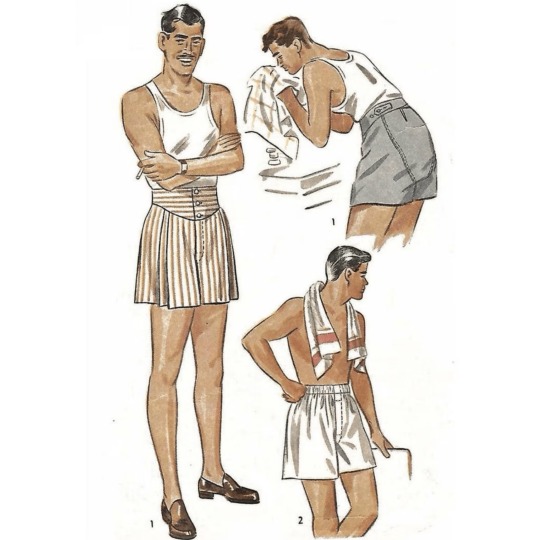
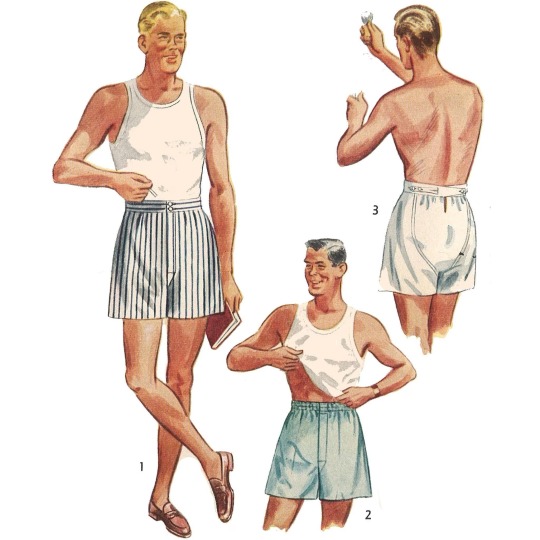
#outing myself as a kryptonians have little fangs hc enjoyer#dc#batfam#superman#ngl their permanently in the 40s to me like I read comics set in contemporary modern day all the time but part of my brain registers them#more like modern au 💀💀#I think it’s cause my fav adaptions are either set in the past or were just created then tbh#also would 100% wear Clark’s suit grandpa librarian core#dc comics#slightlyslothdraws#fanart#digital art#batman#bruce wayne#clark kent#superbat#I mean not really but they’re both here#art#also the way Bruce deaged like 10 years in the Brucie Wayne profile just for having a wash shave and nap 💀💀#accidentally gave Clark a bit of T boy swag bc i am physically incapable of drawing cis ppl
437 notes
·
View notes
Text

Half Human Half Insect
Butterfly or Dragonfly?
#insects#nature core#inaturalist#naturalist#nature#ecology#zoology#biology#insect#bug#bugblr#entomology#bugs#love core#girl core#lovecore#girlcore#contemporary art#contemporary#contemporarypoetry#poetry#abstract art#artwork#abstract#nature poetry#jenny holzer#weird core#ocean core#corecore#boy core
65 notes
·
View notes
Text
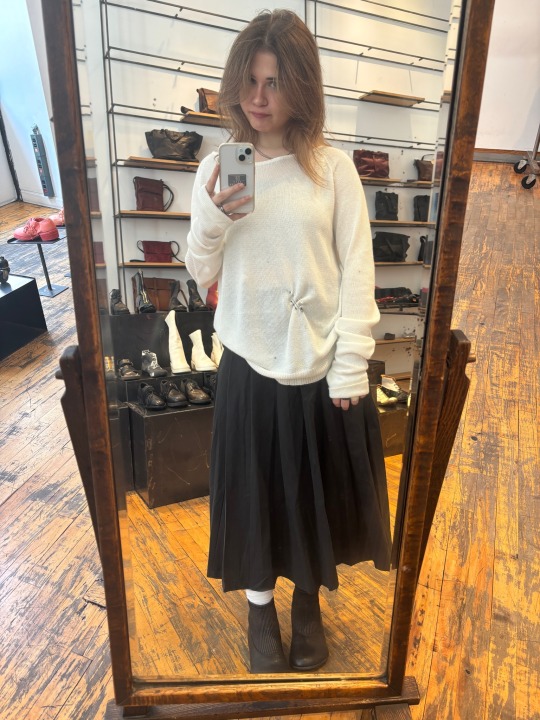
#new york#girlblog#ai girl#archivefashion#avante garde#girl blogger#girl core#comme des garçons#coquette#lana del rey#fashion details#fashion#contemporary fashion#female hysteria#avant garde fashion#it girl#hysteric glamour#girl interrupted#heavn#chrome hearts#issey miyake#japan#lilyrosedepp#maison margiela#miu miu#omighty#rick owens#jean paul gaultier#sylvia plath#simone rocha
87 notes
·
View notes
Text







Lloyd David
#photography #photooftheday #photo #photographer #photoshoot #nature #picoftheday #love #naturephotography #travel #photographylovers #beautiful #travelphotography #art #landscape #godsowncountry #portrait #photos #portraitphotography
Ruby by Tweaker, Will Oldham 🎧

#l o v e#moodboard#Lloyd David#photographer#5/2024#fine photo art#passion#nature#country core#aesthetic#travel#traveling#travelingwithoutmoving#newcontemporary#new contemporary#contemporaryart#contemporary art#x-heesy#now playing#music and art#landscape#travel photography#photographylovers#nature photography#neon aesthetic
47 notes
·
View notes
Text

Beholder
#art#collage#core#emo#goth#weirdcore#webcore#grunge#2014 aesthetic#dark aesthetic#dark art#beige#brown#classical art#contemporary art#montage#trauma core#catholiccore
30 notes
·
View notes
Text

Santa Fe, NM 2019
#aspens#glow up#photographers on tumblr#streetphotography#original photographers#photography#my photography#street photography#landscape#art#contemporary photography#new mexico#pretty#moss aesthetic#Orange#lensbr#lensblr#nature#nature core
35 notes
·
View notes
Text

🧚🏽♀️fairie in the forest🧚🏽♀️
#artblr#fairy cottage#fairy core#enchanted#enchanted forest#fairy ring#fairy aesthetic#glitter aesthetic#illustrative art#black women art#black woman beauty#black goddess#black art#black girl magic#floral#naturecore#spiritual art#contemporary art#art nouveau#surrealism#cartoon art
17 notes
·
View notes
Text


"like i'm a river worth waiting"
first time posting myself on here feeling nervous (don't fatshame me plz it's cause of the clothes)
#me#photography#contemporary#8mm#ethel cain core#night in the woods#what the fuck#melancholia#small town gothic#ruralcore#shitpost#crying during sex#woe#melanchonic#idk what else to tag
11 notes
·
View notes
Text

junya watanabe
#junya watanabe#issey miyake#vivienne westwood#jean paul gaultier#fruits magazine#fruits mag#archive#fashion#girl core#love core#spring#summer core#summer#high fashion#avant garde#miu miu#simone rocha#contemporary art#contemporary fashion#prada#chanel#lovecore#girlcore
5K notes
·
View notes
Text
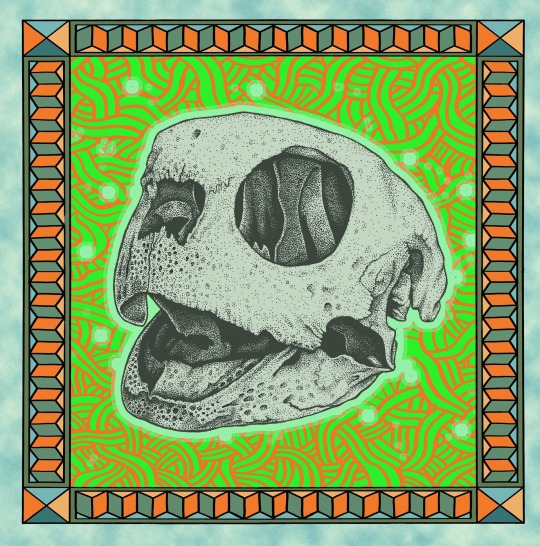
Turtle Skull
#trippy#artists on tumblr#illustration#grunge#dark art#sketchbook#ink drawing#digital art#contemporary illustration#vulture core#pyschedelic#stipple drawing#hand drawn#artist on tumblr#artist#skull art#turtle#nature#scientific illustration#ink
80 notes
·
View notes
Note
Two questions regarding the Wardi religion:
In addition to the bull and the lioness, what are the seven faces of god/sacrificial animals?
Given that white animals seem to be sacred, does that influence how albino humans/other sophents are treated by society?
The seven faces of God are as follows:
-the lunar, horned, or 'wild ox' face of God, which presides over the moons, and the fertility of the land, animals, and people. In pre-imperial times, this was functionally the most central face of God (replaced by the lion face/odomache). The most ideal sacrifice is a wild ox (especially white or albino) that has never been bred. -the ‘ox’ face of God, presides over agriculture and labor, as well as the domestic sphere. The most ideal sacrifice is a healthy plow oxen or khait who has never been yoked or bred (if the sacrifice is towards Ox-Face as the domestic sphere, this should be a heifer). -the lion face of God, presides over sovereignty, statehood, military might, and is most associated with the health and continuing existence of the imperial entity. The most ideal sacrifice is a maned lioness (functionally white, though this is a trait of the captive population). -the ocean or skimmer face of God, presides over the seas, winds, as well as fortune and mercantilism. The ideal sacrifice is the skimmer gull or an albatross, especially one taken from one of the sacred rocks in the 'mouth' of the Viper sea. -the serpent face of God, presides over the cosmos and divine Mysteries, associated with funerary rites and death. Also has a wildly disparate association with royalty (which is derived from entirely separate traditions and has not yet fully been reconciled into the faith). The ideal sacrifice is a two headed or melanistic snake, especially a venomous one (both would be MOST ideal, but this is rare beyond any practicality) -The solar face of God, presides over the sun, stars, and fire, also heavily associated with khait and mounted warriors. (this is a VERY direct import from the chief solar god in the Burri pantheon (who rides and/or is a khait with the sun between its horns), hence the seemingly random khait association). The ideal sacrifice is a healthy riding khait (especially with a white spotted coat), or alternatively a golden eagle. -The river face of God, presides over fresh water, seasonal flooding, and the rains. The ideal sacrifice is the migratory reed duck (which arrives at the onset of the wet season) or a freshwater hesperornis (ideally taken from one of the sacred waters). An-Nechoi are also occasionally given.
Though the core religion is monotheistic, each face of God is functionally a syncretic fusion of older ethnic Wardi beliefs, the Burri pantheon, and other regionally native traditions, which have not all been fully reconciled (the process of fusion is more or less still ongoing). Each face in of itself has dozens or more epithets with distinct features. For example, the river face has a specific epithet for each major riverway, each venerated as a distinct aspect of the Godhead. Functionally, common practice of the Wardi faith is pretty indistinguishable from polytheism, and most of the religious authority does not care as long as required orthopraxy is maintained (the central dogma of the religion does not care How you believe, but that the correct practices are enacted).
Also for reference, these are the specific animals taken on the pilgrimage in the story (transporting seven rare animals cross country can be fraught, so each had at least a few backups):
A pure white aurochs calf, found naturally born in a wild herd.
A massive, unbred and unyoked bull draft khait (dies en route, replaced by a less physically impressive backup with the same qualities)
A lioness with a full mane, from the white captive stock
A skimmer gull taken from a nest on the sacred rock in the waters of Od-Koto.
A baby two headed cobra (which dies en-route and is replaced with its backup, a melanistic viper)
A beautiful speckled riding khait mare whose horns form a near perfect circle (which is stolen en-route and replaced with its sister)
A rare wild hesperornis (haven't come up with an in-universe name yet) taken from the reeds of the Brilla river delta.
Anyway the sacrifices listed above are considered the absolute IDEALS when working with a specific face, but a great variety of animals will be sacrificed to various ends. There’s some very specific cultural/religious components to which animals are most valued, but in practice the value of a sacrifice is pretty close to 1:1 with the animal’s monetary value, at an intersection of utility and rarity.
So a young, healthy bull plow oxen who has never been bred or yoked is a more valued sacrifice than an old, experienced plow ox who has already sired offspring. You are giving up an extremely valuable animal and all its unused potential in a very practical sense, which makes the sacrifice more potent and valued. The 'virginal' status of the animal is key when the rite is SPECIFICALLY related to fertility, in the sense that the animal itself is sacrificing its unused fertility, allowing for the sacrifice-rebirth cycle to perpetuate. (Animals which Have been bred may be preferred in certain cases and rituals).
An animal with a rare coloration is usually going to be more valuable than one with more common genetics. This is the core root of why albino animals are of high value. It's less that white animals themselves are valued, just that rare genetics such as albinism = valuable sacrifice.
There are some specific exceptions where the color itself is significant (rather than just an extension of its rarity). God is specifically supposed to have taken the form of a white aurochs (itself emerged from the foam of the sea) during creation, so white oxen and wild oxen SPECIFICALLY have especially high value. Melanism or black scales are valued to the serpent face of God, which is associated with the cosmos and void behind the stars. (this stems from much, MUCH older beliefs in a cosmic serpent god in the region).
Animal sacrifice is a very significant part of the religious framework and involved in most rituals and prayers intended to affect significant change and transformation. (This is due in part to a deeply ingrained belief in the world being perpetually sustained in a cycle of sacrifice and rebirth, and in God Itself being the physical mechanism of rebirth and requiring sacrifice to be sustained). While blood itself is seen as potent, the nature of sacrifice isn't just 'spill blood and make thing happen', it's got a self contained value system and is very calculated and intentional in nature. You aren’t going to just grab a random rat and bleed it and pray, there needs to be a perceived ‘loss’. Sacrifice via killing is also not the only form, the most common day to day sacrifice is in (very minor) bloodletting and offerings of food and drink- the key is allowing a personal loss to sustain a greater cycle.
That being said, there is a HUGE trade system built up around the breeding and selling of animals solely for sacrifice. The industry revolves mostly around birds (doves are the cheapest, but also poultry, waterfowl, some birds of prey, a few select songbirds and ornamental birds), goats, sheep, and horses (the small, premodern kind). Cattle and camelids are a higher tier, and khait are among the highest of common sacrifices due to their great value.
Other animals that have no direct utility but are sacred are also bred or captured for sacrifice (hesperornis, lacetor, gulls and albatrosses, several kinds of snake, a bunch of wild ungulates, nechoi, etc). Some '''‘exotic’''' animals are imported specifically for this purpose, mostly as a means of displaying the wealth and reach of the state, with their sacrificial value rooted in the difficulty of acquisition. Animals taken from sacred sites are also prime candidates (ie cattle bred and grazed on the foothills of the Sons of Creation are VERY valuable).
---
So all that being said the importance of albino animals has come off a little overstated on my part, and doesn't have any particular impact on how albinism in people is regarded. It’s valued mainly for its rarity in the context of animal sacrifice, which would not have direct translations to how it’s perceived in people.
Albinism in people doesn’t have a super well defined significance in broader Imperial Wardi culture, but perspectives mostly skew negative and towards seeing it as a sign of ill fortune (physical differences in people tend to be seen as a result of being cursed in the womb). Imperial Wardin is culturally diverse (united mostly by a identity based in shared religion), so exact nuances would vary and this statement should not be taken as a universal.
Imperial Wardi population is mostly human (with its citizen population being MAYBE 5% elowey, 2% qilik, and a decimal point of caelin). Overall sentiment towards other sophonts by the human majority is not outright hostile, but is human-centric and tinged with xenophobia (as most qilik and elowey in the region are immigrants, with the only elowey ethnic group historically inhabiting the region (the Jazait) being regarded as 'heathens'). Albino elowey or qilik might be similarly seen as products of a curse, or may be given a 'wow how beautiful' treatment (in a heavily patronizing capacity) and seen as a curiosity, or otherwise just subject to varying perspectives on albinism in the region.
The one other thing I have established in this vein is that the semi-mythological hero Janise (sworn brother of other semi-mythological founder hero Erub) is said to have been albino. While he is positively regarded, he is supposed to have died young of a snakebite (assumed to be the product of a curse from his enemies) and this would not improve perceptions of albinism being related to ill fortune.
#For a while I was typing aurochs as aurox. And this WAS intentional but I don't know what the point was because neither word would#be used in-universe (it's just translated as 'wild ox' in text) and it's not indicating a distinction with a real animal (like 'tyger' is).#So yeah it's back to just 'aurochs'.#Also Janeys is named after the historical Janise ('Janeys' is a more contemporary variant and is also a SUPER common name)#(variants include Janis Janes Jannes Janey Jani Jane Janus.....etc)#There's also like 10 trillion people named Erub or Erubi or Erubin or Erubnos or Urib or Urbi or Urbin .. etc#Super committed to realism by having several characters in the same story with the same name. There's like 4 background#characters with Erub names and 2 other Janeys variants. Which is hard on the reader and kind of bad writing but suffer with me. etc.#None of this is related to core post questions I just can't not elaborate on various niche details#OH ONE SEMI RELEVANT THING. Hesperornis is not extinct in this setting but only freshwater species survive in the contemporary#They don't get as big as the marine species we know from Real Life but they're still pretty big and flightless and only live in#large healthy river in this region (therefore are increasingly diminished) and are considered sacred#I got a couple drawings on deck that involve them but I don't think they've come up on here before#the white calf#imperial wardin
58 notes
·
View notes
Text

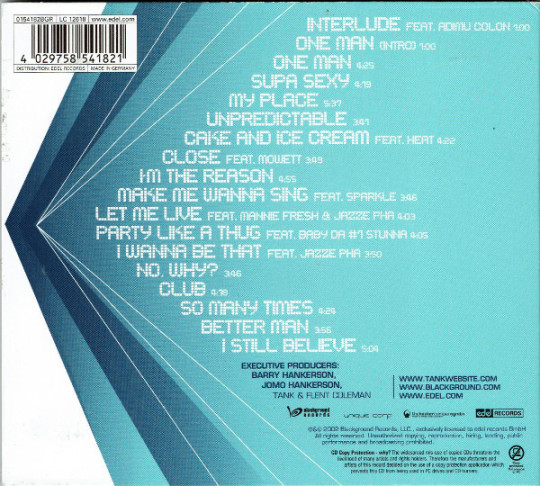

One Man - Tank (2002)
#2002#2000s#02#00s#art#black#blue#cd#contemporary r&b#cybercore#cyber y2k#design#disc#europe#funk#graphic design#kaybug#music#photography#scans#soul#tank#white#y2kcore#y2kore#y2k aesthetic#y2k core#y2k cyber#y2k design#y2k fonts
26 notes
·
View notes
Text
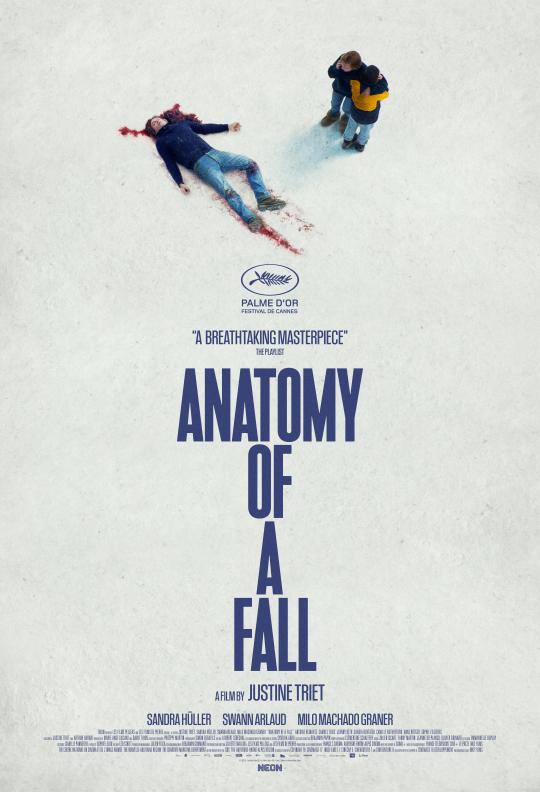

barbenheimer for people whose IQ is in the double digits at the very least
#actual contemporary feminist and lgbt societal critique & a deeply humanist tragedy with love and brotherhood and humanity at its core#society of the snow and anatomy of a fall THE OSCAR GOES TO YOU !!!!!!!!!!#FAAWK BARBIE AND OPPENHEIMER !!!!!!!!!!!!!!!!!!!!!!! FAWKING HATE THOSE MOVIES#bakma bana#im here to incentivize you all to watch these two movies bc my lame ass watching baftas rn hoping sots gets the award 😭😭😭#watching award shows at my big age it's so wack but i want recognition for SOTS it's literally the best movie made in the last 10 years#WATCH SOCIETY OF THE SNOW NNEOOWWWWW!!!!!!!!!!#society of the snow#anatomy of a fall
35 notes
·
View notes